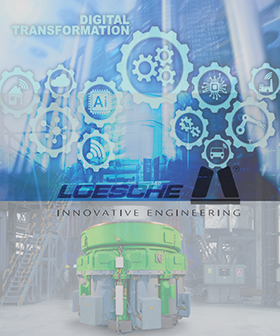

Cement is one of the most energy-intensive industries, and a typical cement plant consumes around 100 kWh of energy for each ton of production. This is equivalent to over 6% of global energy consumption. More than 60% is used in the comminution units (crushers and mills) to reduce the particle size of the raw materials and clinker. In the early 1900s, the vertical roller mill (VRM) was introduced to the cement industry to reduce energy consumption.
Besides lowering power consumption, VRMs simplified the process since they could simultaneously implement the milling and drying processes. However, controlling VRM performance and understanding the relationships between the operational variables remained a problem. The conventional VRM controlling systems relied on the field staff to adjust the process parameters manually. This often led to an unstable system, increased power consumption, and reduced plant productivity.
Today, however, LOESCHE’S software solution systems can automatically assess a VRM’s process parameters and help optimise power consumption, improve maintenance, reduce environmental issues and make the process sustainable. Here are three case studies showing how Loesche’s MILLMASTER software has made a difference to cement operations.
Fully autonomous mill operation at EQIOM Ciment
MILLMASTER was implemented in an automation project at EQIOM Ciment’s VRM plant in Dunkerque, Northern France. EQIOM produces slag cement. Now the plant is operated completely unmanned over the weekend, and MILLMASTER runs the mill fully autonomously. “The MILLMASTER system is used daily and gives us the opportunity to concentrate on performance optimisation while the mill is running. It is also faster than an operator when it comes to protecting the equipment in case of important changes in mill behaviour. It would be hard to run for a long period without this expert system,” says EQIOM operations manager, Pierre Vonstein.
Increased production at Fabrika Cementa Lukavac
A key advantage of the MILLMASTER system is that it can be configured so that operators do not need to see the details. All that is needed is to trigger the on/off switch to start or stop the auto-pilot. An example is Fabrika Cementa Lukavac in Bosnia and Herzegovina. The MILLMASTER system was installed on a 65 tph ball mill, which usually reached a base line of 67 tph, as reported by process manager, Emir Cilimkovic. This resulted in a production increase greater than 10%. In addition, fluctuations in quality were reduced. There was also less wear of grinding media and mill liners because of the higher material level in the mill.
Increased production at Opterra Karsdorf, Germany
After the merger of Lafarge and Holcim, many plants had to terminate their expert systems. These had required a certain level of support by technology centres, with experts visiting on a regular basis to maintain successful day-to-day operation. Following this, suppliers were asked to quote on a system to equip these plants with “an alternative software system that offers the same performance as the previous systems, but with easier handling from the plant site, and without the necessity for regular maintenance from external resources”.
KIMA Echtzeitsysteme was awarded the contract to equip all ball mills at the plants that had been acquired by CRH in Germany. While there were a few concerns about this small, but well-established supplier, it was also known that the company had previously equipped over 30 Holcim plants in Eastern Europe with smart control systems such as MILLMASTER.
The former Lafarge plant in the small eastern German town of Karsdorf was equipped with the MILLMASTER expert system. In total, six cement mills, four of them centre discharge mills, received an individual software package and parameterisation to reach the challenging optimisation guarantee of a 5 to 8% increase in production, or alternatively a 4 to 6% reduction in specific energy demand. The onsite commissioning of MILLMASTER on the VRM took no longer than five days. The rest of the work was executed remotely.
All performance goals of the project at Karsdorf were reached. An important benefit was that the expert systems had total acceptance by the operators, as reported by the performance engineer on the plant, Tim Fröhlich.
Conclusion
The basic principles of AI today are similar to those from ten or 20 years ago; but today’s computers are much faster and have access to massive amounts of data. Loesche’s software solutions are proving themselves globally, and result in significant energy consumption savings, increased production, and more sustainable processing.
| Tel: | +27 11 482 2940 |
| Email: | [email protected] |
| www: | www.loesche.com |
| Articles: | More information and articles about Loesche South Africa |

© Technews Publishing (Pty) Ltd | All Rights Reserved